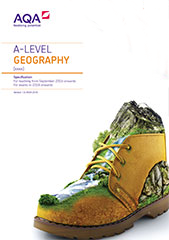3.2.1 Global systems and global governance
This section of our specification focuses on globalisation – the economic, political and social changes associated with technological and other driving forces which have been a key feature of global economy and society in recent decades.
Increased interdependence and transformed relationships between peoples, states and environments have prompted more or less successful attempts at a global level to manage and govern some aspects of human affairs. Students engage with important dimensions of these phenomena with particular emphasis on international trade and access to markets and the governance of the global commons. Students contemplate many complex dimensions of contemporary world affairs and their own place in and perspective on them. Study of this section offers the opportunity to exercise and develop both qualitative and quantitative approaches to gathering, processing and interpreting relevant information and data including, those associated with and arising from fieldwork.
Globalisation
Dimensions of globalisation: flows of capital, labour, products, services and information; global marketing; patterns of production, distribution and consumption.
Factors in globalisation: the development of technologies, systems and relationships, including financial, transport, security, communications, management and information systems and trade agreements.
Global systems
Form and nature of economic, political, social and environmental interdependence in the contemporary world.
Issues associated with interdependence including how:
- unequal flows of people, money, ideas and technology within global systems can sometimes act to promote stability, growth and development but can also cause inequalities, conflicts and injustices for people and places
- unequal power relations enable some states to drive global systems to their own advantage and to directly influence geopolitical events, while others are only able to respond or resist in a more constrained way.
International trade and access to markets
Global features and trends in the volume and pattern of international trade and investment associated with globalisation.
Trading relationships and patterns between large, highly developed economies such as the United States, the European Union, emerging major economies such as China and India and smaller, less developed economies such as those in sub-Saharan Africa, southern Asia and Latin America.
Differential access to markets associated with levels of economic development and trading agreements and its impacts on economic and societal well-being.
The nature and role of transnational corporations (TNCs), including their spatial organisation, production, linkages, trading and marketing patterns, with a detailed reference to a specified TNC and its impacts on those countries in which it operates.
World trade in at least one food commodity or one manufacturing product.
Analysis and assessment of the geographical consequences of global systems to specifically consider how international trade and variable access to markets underly and impacts on students' and other people's lives across the globe.
Global governance
The emergence and developing role of norms, laws and institutions in regulating and reproducing global systems.
Issues associated with attempts at global governance, including how:
- agencies, including the UN in the post-1945 era, can work to promote growth and stability but may also exacerbate inequalities and injustices
- interactions between the local, regional, national, international and global scales are fundamental to understanding global governance.
The 'global commons'
The concept of the ‘global commons’. The rights of all to the benefits of the global commons. Acknowledgement that the rights of all people to sustainable development must also acknowledge the need to protect the global commons.
Antarctica as a global common
An outline of the contemporary geography, including climate, of Antarctica (including the Southern Ocean as far north as the Antarctic Convergence) to demonstrate its role as a global common and illustrate its vulnerability to global economic pressures and environmental change.
Threats to Antarctica arising from:
- climate change
- fishing and whaling
- the search for mineral resources
- tourism and scientific research.
Critical appraisal of the developing governance of Antarctica. International government organisations to include United Nations (UN) agencies such as United Nations Environment Programme (UNEP) and the International Whaling Commission. The Antarctic Treaty (1959), the Protocol on Environmental Protection to the Antarctic Treaty (1991); IWC Whaling Moratorium (1982) – their purpose, scope and systems for inspection and enforcement.
The role of NGOs in monitoring threats and enhancing protection of Antarctica.
Analysis and assessment of the geographical consequences of global governance for citizens and places in Antarctica and elsewhere to specifically consider how global governance underlies and impacts on students’ and other people's lives across the globe.
Globalisation critique
The impacts of globalisation to consider the benefits of growth, development, integration, stability against the costs in terms of inequalities, injustice, conflict and environmental impact.
Quantitative and qualitative skills
Students must engage with quantitative and qualitative approaches across the theme as a whole.
